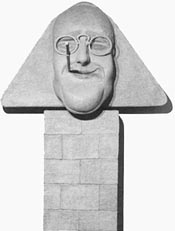
Oddities, Etc.: A Display of Affection
Summer 2001, Vol. 33, No. 2
"I am sending you a handkerchief with your initial on it. I put the initial on it myself. It is not very big but it will be all right unless you have a bad cold."
- Twelve-year-old Clara Bell Allen's handwritten note accompanying her gift to FDR
In commemoration of the sixtieth anniversary of the Franklin D. Roosevelt Presidential Library, "Oddities, Etc. A Display of Affection" opened on May 3, 2001, and runs through October 31, 2001. It is an exhibition of gifts to President and Mrs. Roosevelt that includes magnificent objects given by heads of state as well as tokens, trinkets, and works of art sent by ordinary men, women, and children. Some are objects of great beauty, and skill; others are more irreverent, which led Roosevelt to call them his "oddities."
The Roosevelt Library assembled the exhibition to mark this very special event in the history of presidential libraries. As the first presidential library, the displays at the Roosevelt Library for the first time gave people the opportunity to view a President's personal collection and gain a rare glimpse into the private side of the nation's chief executive. But FDR wanted the museum to be far more than the books, ship models, stamps, and naval art that composed his own collections. He cherished the things people gave him and, no matter what the type or quality, felt that they represented the nation's love and respect, not only for him personally, but for the presidency itself.
"Oddities, Etc." showcases many of the original items that the very first visitors to the Roosevelt Library and Museum saw on June 30, 1941. Many were originally displayed in the library in the "Gift Room," a basement gallery that FDR affectionately called his "Oddities Room." Other objects in the exhibition are drawn from the more traditional presidential gifts displayed in the library's main exhibition hall.
The exhibition includes images of FDR in embroidery, mosaic, cross stitch, and wood inlay; some are quite handsome, some humorous, others outrageous. A portrait of FDR done entirely by typewriter and presented to the President is the work of a young Philadelphian, Sidney Cohen, who was suffering from a chronic nervous ailment. The patience and ingenuity required to reproduce the picture (which took two years of concentrated effort) expressed the depth of affection many felt for President Roosevelt. Other oddities include a pipe with the President's head carved in the bowl, a photograph of the President framed in two scrolling circles of postage stamps rolled to points, a mosaic portrait in colored glass with a tile frame, a framed double portrait of FDR done in pencil and set in the middle of a large and elaborate design made of thousands of pieces of colored wood-pencil shavings, and hand-colored statuettes of the President and Mrs. Roosevelt carved in wood.
A vest covered with hundreds of buttons in different sizes and colors was made by Mrs. Luella Smith of Inglewood, California. It carries an inscription on the back in small white buttons, "FDR 1944." The letter that accompanied the vest from Mrs. Smith said she was praying for FDR's success and that her hope had always been with him. She asked that he have his picture taken in the vest and requested a copy to put on her bedstand so she could admire her boy in the White House. We doubt Mrs. Smith ever got her photograph, but FDR sent the vest to the library for display in the Oddities Room.
Certainly not odd in the same sense as pencil-shaving pictures and button vests is a sterling silver and gold clock made by Mr. Bernard Kohn of New York City and presented to the President and Mrs. Roosevelt on the occasion of the laying of the cornerstone for the library in November 1939. The movement registers both Pacific and Eastern Time so that the Roosevelts would know when to call their children who lived on the West Coast. The case of the clock consists of forty-eight parts representing the states then in the Union. Depicted in an arch over the dial supported by four gold-plated columns are the motto "E Pluribus Unum," the American eagle and shield, reproductions of the Capitol and the White House, and an enameled portrait of the President framed in a wreath. The hands of the clock are solid gold and shaped like the Empire State Building to signify the President's home state. Kohn described the work as a labor of love, designed and built unhurriedly, as an enduring symbol of deep devotion to an idealist and his ideals. The clock represented six years of painstaking work.
The showpiece of "Oddities, Etc. A Display of Affection" is an outrageously huge papier-mâché head of FDR resembling the sphinx that was presented to him at the 1939 Gridiron Dinner when the President refused to answer questions about running for a third term. The sphinx was designed and executed by James Preston, assistant administrative secretary of the National Archives. Hours and hours of painstaking work in the basement of his home with wire and wet newspaper produced this amazing caricature of FDR. The entire piece is seven feet tall and the face itself forty inches long. The famous cigarette and holder extend out a nearly a yard. FDR was so pleased with the image he asked for it and had it shipped to the library, which was under construction at the time. It attracted great public attention on opening day sixty years ago and is the hit of today's exhibit.
See the related article:
